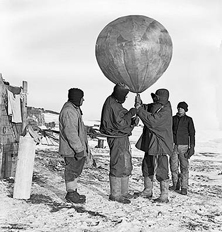Antarctica is the highest, driest and most remote of all continents yet we know remarkably little about its weather and how it fits into the global picture. We have joined with Prof. Chris Turney and Dr Chris Fogwill from the Climate Change Research Centre, University of New South Wales, in an innovative new research project to take advantage of ALE’s expeditions.
Historical Weather Observations
 1912 was an exceptional year during which five major expeditions set out to understand what made Antarctica tick. Teams of scientists collected sledge-loads of rocks, plants and animal remains, and took measurements of the air, snow and ice. Meteorological observations were foremost among this data collection. Arguably the greatest set of weather observations were those made by George Simpson on Scott’s ill-fated British Antarctic (Terra Nova) Expedition.
1912 was an exceptional year during which five major expeditions set out to understand what made Antarctica tick. Teams of scientists collected sledge-loads of rocks, plants and animal remains, and took measurements of the air, snow and ice. Meteorological observations were foremost among this data collection. Arguably the greatest set of weather observations were those made by George Simpson on Scott’s ill-fated British Antarctic (Terra Nova) Expedition.
2012 Field Observations
During the 2012-13 season, several of our expeditions are setting out from the coast for the pole, taking different routes and staggered throughout the season. This provides an exceptional opportunity to obtain a complete snapshot of the weather during this centenary year. We are asking some of these expeditions to help us improve our scientific understanding of this great continent. Expeditions will be provided with a Kestrel 4500 weather meter capable of measuring temperature, pressure, wind speed and direction, and humidity, and will be asked to take daily weather observations. Lightweight iButton temperature sensors, capable of continuous self-recording measurements, will be attached to one of the expedition sleds and the data downloaded at Union Glacier camp at the end of the trip.
This joint project between UNSW and ALE will add to Antarctic weather databases and help to improve understanding of Antarctic meteorology.